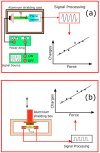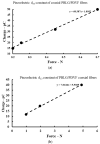Significant Electromechanical Characteristic Enhancement of Coaxial Electrospinning Core-Shell Fibers
- PMID: 35566908
- PMCID: PMC9099492
- DOI: 10.3390/polym14091739
Significant Electromechanical Characteristic Enhancement of Coaxial Electrospinning Core-Shell Fibers
Abstract
Electrospinning is a low-cost and straightforward method for producing various types of polymers in micro/nanofiber form. Among the various types of polymers, electrospun piezoelectric polymers have many potential applications. In this study, a new type of functional microfiber composed of poly(γ-benzyl-α,L-glutamate) (PBLG) and poly(vinylidene fluoride) (PVDF) with significantly enhanced electromechanical properties has been reported. Recently reported electrospun PBLG fibers exhibit polarity along the axial direction, while electrospun PVDF fibers have the highest net dipole moment in the transverse direction. Hence, a combination of PBLG and PVDF as a core-shell structure has been investigated in the present work. On polarization under a high voltage, enhancement in the net dipole moment in each material and the intramolecular conformation was observed. The piezoelectric coefficient of the electrospun PBLG/PVDF core-shell fibers was measured to be up to 68 pC N-1 (d33), and the voltage generation under longitudinal extension was 400 mVpp (peak-to-peak) at a frequency of 60 Hz, which is better than that of the electrospun homopolymer fibers. Such new types of functional materials can be used in various applications, such as sensors, actuators, smart materials, implantable biosensors, biomedical engineering devices, and energy harvesting devices.
Keywords: PBLG; PVDF; core–shell fibers; electromechanical transducer; electrospinning; energy harvesting devices; implantable biosensors; piezoelectric fibers.
Conflict of interest statement
The authors declare no conflict of interest.
Figures









Similar articles
-
Enhanced Piezoelectricity of Electrospun Polyvinylidene Fluoride Fibers for Energy Harvesting.ACS Appl Mater Interfaces. 2020 Mar 18;12(11):13575-13583. doi: 10.1021/acsami.0c02578. Epub 2020 Mar 4. ACS Appl Mater Interfaces. 2020. PMID: 32090543 Free PMC article.
-
Structure-Properties Relationship of Electrospun PVDF Fibers.Nanomaterials (Basel). 2020 Jun 23;10(6):1221. doi: 10.3390/nano10061221. Nanomaterials (Basel). 2020. PMID: 32585824 Free PMC article.
-
Modulus-Modulated All-Organic Core-Shell Nanofiber with Remarkable Piezoelectricity for Energy Harvesting and Condition Monitoring.Nano Lett. 2023 Mar 8;23(5):1810-1819. doi: 10.1021/acs.nanolett.2c04674. Epub 2023 Jan 17. Nano Lett. 2023. PMID: 36648158
-
Advancements in Flexible Nanogenerators: Polyvinylidene Fluoride-Based Nanofiber Utilizing Electrospinning.Molecules. 2024 Jul 29;29(15):3576. doi: 10.3390/molecules29153576. Molecules. 2024. PMID: 39124980 Free PMC article. Review.
-
Electrospun PVDF Nanofibers for Piezoelectric Applications: A Review of the Influence of Electrospinning Parameters on the β Phase and Crystallinity Enhancement.Polymers (Basel). 2021 Jan 6;13(2):174. doi: 10.3390/polym13020174. Polymers (Basel). 2021. PMID: 33418962 Free PMC article. Review.
Cited by
-
Cleaner and Sustainable Production of Core-Sheath Polymer Fibres.Polymers (Basel). 2024 Aug 20;16(16):2357. doi: 10.3390/polym16162357. Polymers (Basel). 2024. PMID: 39204576 Free PMC article.
-
Electrosprayed Stearic-Acid-Coated Ethylcellulose Microparticles for an Improved Sustained Release of Anticancer Drug.Gels. 2023 Aug 29;9(9):700. doi: 10.3390/gels9090700. Gels. 2023. PMID: 37754381 Free PMC article.
-
The Applications of Ferulic-Acid-Loaded Fibrous Films for Fruit Preservation.Polymers (Basel). 2022 Nov 16;14(22):4947. doi: 10.3390/polym14224947. Polymers (Basel). 2022. PMID: 36433073 Free PMC article.
-
Enhanced Hybrid Nanogenerator Based on PVDF-HFP and PAN/BTO Coaxially Structured Electrospun Nanofiber.Micromachines (Basel). 2024 Sep 21;15(9):1171. doi: 10.3390/mi15091171. Micromachines (Basel). 2024. PMID: 39337831 Free PMC article.
-
Progress in Microtopography Optimization of Polymers-Based Pressure/Strain Sensors.Polymers (Basel). 2023 Feb 2;15(3):764. doi: 10.3390/polym15030764. Polymers (Basel). 2023. PMID: 36772064 Free PMC article. Review.
References
-
- Sezer N., Koç M. A comprehensive review on the state-of-the-art of piezoelectric energy harvesting. Nano Energy. 2020;80:105567. doi: 10.1016/j.nanoen.2020.105567. - DOI
-
- Filippin A.N., Sanchez-Valencia J.R., Garcia-Casas X., Lopez-Flores V., Macias-Montero M., Frutos F., Barranco A., Borras A. 3D core-multishell piezoelectric nanogenerators. Nano Energy. 2019;58:476–483. doi: 10.1016/j.nanoen.2019.01.047. - DOI
-
- Lu L., Yang B., Zhai Y., Liu J. Electrospinning core-sheath piezoelectric microfibers for self-powered stitchable sensor. Nano Energy. 2020;76:104966. doi: 10.1016/j.nanoen.2020.104966. - DOI
LinkOut - more resources
Full Text Sources

